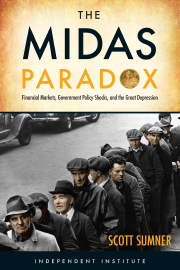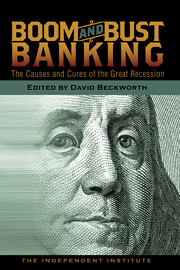See if this sounds familiar. The economy is in a deep slump. The Fed cuts interest rates close to zero and then tries quantitative easing (QE). A banking crisis begins in the United States and then spreads to Europe, where even sovereign debt is no longer safe. Individual countries are locked into a single monetary regime and unable to stimulate their economies.
Am I my describing the Great Recession? Yes, but I’m also describing the Great Depression of the early 1930s. Now let’s push the comparison a bit further.
At the time, the Depression was widely viewed as representing the failure of unbridled capitalism. Monetary policy was assumed to be expansionary but ineffective. So far I’m still describing both the 1930s and recent history.
Today, however, the Great Depression is seen very differently, thanks to the path-breaking research of Milton Friedman and Anna Schwartz. Even former Fed Chair Ben Bernanke admits that the Federal Reserve caused the Great Depression, with a highly contractionary monetary policy. But how could this be, given that the Fed cut interest rates close to zero and also did substantial QE during the 1930s?
Bernanke provides an answer in an academic paper in which he points out that neither interest rates nor money creation are good indicators of the actual stance of monetary policy. Instead, Bernanke argues that you need to look at nominal GDP growth and inflation, both of which fell sharply during the early 1930s and more modestly in the 2008-09 period.
During much of my academic career I studied the role of the gold standard in the Great Depression, and recently published a book on my findings. During the banking crisis of 2008 and the associated recession, I couldn’t help but notice a number of parallels with the much deeper slump of the 1930s. One, which I’ve already alluded to, was the widespread misdiagnosis of the stance of monetary policy. Just as in the 1930s, most people — even most economists — initially assumed that the stance of monetary policy was highly expansionary in the period after 2008. As in the 1930s, people focused too much on the inputs into monetary policy, such as interest rates and QE, and not enough on the output, inflation and nominal GDP growth.
But the parallels don’t stop there. Perhaps the most striking similarity is between the Eurozone and the interwar gold standard. In both cases, individual countries had little or no control over monetary policy. And in both cases, the crisis was misdiagnosed. It was assumed that the financial crisis was causing a recession, whereas the reverse was more nearly true. The deep slump worsened the fiscal situation of countries in two ways: making the budget deficit larger and also reducing national income available to pay off sovereign debt.
The U.S. economy finally began to recover after Franklin Roosevelt began devaluing the dollar in April 1933. Initially the recovery was quite rapid, with industrial production rising by 57 percent between March and July 1933. But then FDR issued an executive order that effectively pushed hourly wages up by roughly 20 percent in just two months. Industrial output leveled off until May 1935, when the Supreme Court declared the wage and price-fixing program to be unconstitutional.
The wage shock of July 1933 would be just the first of five such shocks. In all five cases, growth in industrial production slowed sharply after wages were artificially increased by government policy changes, slowing the recovery. The economy remained deeply depressed as late as the spring of 1940 — seven years after FDR took office.
There are many lessons from the Depression for today’s economy.
Conservatives need to be more aware of the cost of large shortfalls in nominal GDP. When monetary policy allows NGDP to fall well below trend, unemployment increases and financial crises develop or intensify. But instead of blaming the Fed, most people blame capitalism, and we end up with counterproductive statist policies.
Liberals need to be more cautious in advocating large increases in the minimum wage. It’s true that some studies suggest that small increases have little effect. But the minimum wage was already increased by roughly 40 percent right as we were sliding into the Great Recession. If it were to be doubled to $15, as some progressives now advocate, the cost in jobs could be quite significant.








